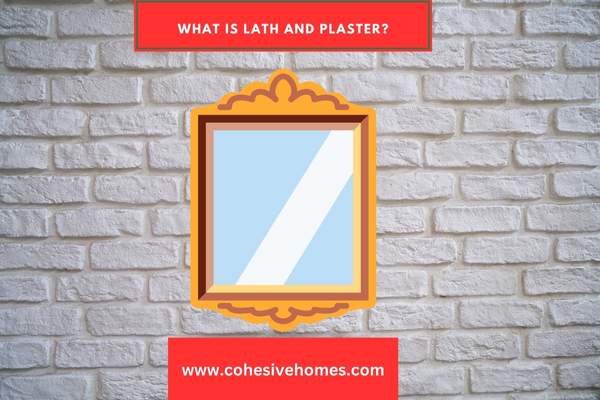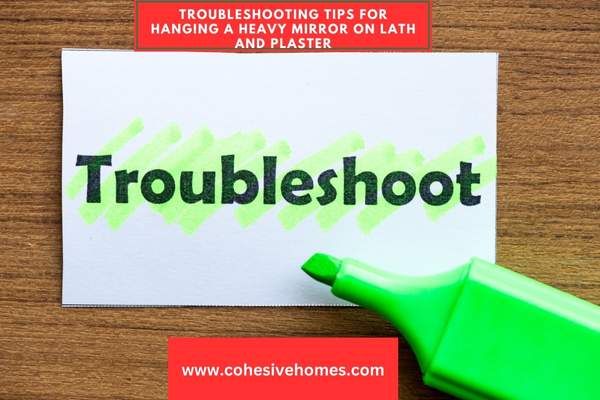Are you ready to hang up your heavy mirror but don’t know how? If you’re dealing with lath and plaster walls, it can be a bit intimidating.
Don’t fear! Hanging a heavy mirror on a lath and plaster wall doesn’t have to be overwhelming or difficult. With the proper tools and preparation, it can be done quickly and securely.
In this article, we’ll walk you through the steps of hanging a heavy mirror on lath and plaster walls, so that you can get your decor finished in no time. We’ll share some tips for doing it correctly so that your mirror is firmly secured for years to come. Now let’s get started!
Hanging a heavy mirror on a lath and plaster wall requires the use of the correct tools and hardware to ensure the mirror stays securely in place
What Is Lath and Plaster?

If you’re planning to hang a heavy mirror on your lath and plaster wall, it is important that you understand how this type of wall works.
Lath and plaster walls are a combination of wooden laths (strips of wood) and a plaster mixture that is troweled onto the laths.
This combination provides an even finish and is much more sturdy than drywall.
Not only are lath and plaster walls sturdy, but they also provide better insulation than drywall, which can translate into savings on your energy bill.
However, since these walls have gypsum or lime-based plaster instead of drywall, the approach to hanging heavy objects such as a mirror needs to be slightly different.
Fortunately, it’s not too difficult, and most hardware stores have the right hardware for this job. You just need to make sure you’re using the right drill bits and screws in order to ensure your heavy mirror will stay put.
And with proper installation technique and materials, you can rest assured that your mirror won’t be making any unexpected trips down the wall!
Preparing to Hang a Heavy Mirror on a Lath and Plaster Wall

When it comes to hanging a heavy mirror on a lath and plaster wall, the most important thing to remember is preparation. It’s essential that you take the time to get your wall and its surroundings ready for the installation.
Start by making sure the area of the wall where you plan to hang your mirror is clean and dry. Any dust or moisture on the surface could lead to problems later down the line, so make sure you get it all out of the way first.
Next, you’ll have to make sure that the lath and plaster wall is strong enough to support your mirror. If it’s weak or damaged, you’ll need to patch it up before proceeding.
You may also want to consider inserting a baton into the wall that will act as an additional support for heavier mirrors.
Once you’ve done all this preparation work, you can finally start thinking about how and where exactly you’re going to hang your heavy mirror on your lath and plaster wall!
Tool List for Hanging a Heavy Mirror on Lath and Plaster

Hanging a heavy mirror on lath and plaster is not as difficult as it sounds, but you will need the right tools. Here’s a list of what you’ll need:
- Drill
- Phillips screwdriver
- Large toggle bolts
- Pencil or marker
- Level
- Measuring Tape
You’ll also want to make sure you have some scrap pieces of wood and cardboard lying around to protect your walls from the drill bit, and for any shimming or propping the mirror might need before it’s mounted.
When drilling into lath and plaster walls, it’s important to go slow; otherwise, you risk breaking or cracking the drywall.
If that happens, your job will get much more complicated. So take your time while drilling and make sure you’re using the right size bit for your toggle bolts.
For added reinforcement, add a second bolt at least 4 inches above or below the first one. Finally, use a level to ensure your heavy mirror is even before you tighten everything down.
Step by Step Instructions for Hanging a Heavy Mirror on Lath and Plaster

Hanging a heavy mirror on lath and plaster may seem intimidating, but it doesn’t have to be. You can hang your perfect piece in your home quickly with the right tools and materials.
Follow these simple steps for a successful installation:
1. Get the right hardware
The key to hanging a heavy mirror on lath and plaster is choosing the right hardware.
You’ll need lath anchors, as they provide additional support since they hold better on the surface of plaster walls than regular wall anchors do. Make sure you get the right size for your mirror.
2. Gather your tools
To perform the job safely and efficiently, you will require some fundamental home improvement tools such as a hammer, drill, nails, screws, and screwdriver.
For best results, use a drill bit that is slightly smaller than the diameter of the screws you’re using and make sure it’s compatible with your drill.
3. Prepare your space
Before you start drilling holes for your lath anchors, make sure you clear away any furnishings that are close to where you’ll be working to prevent damage from flying debris when drilling into the wall.
You should set up an area outside of where you plan to hang your heavy mirror, so you can quickly sweep away or vacuum any dust or debris after completing the drilling process.
4. Attach the hardware
Place each lath anchor carefully into its pre-drilled hole on either side of where you want your mirror to hang (it’s often easiest if each anchor is placed one directly above or below the other).
Make sure that each anchor rests securely in
Troubleshooting Tips for Hanging a Heavy Mirror on Lath and Plaster

If you’re having trouble hanging a heavy mirror on your lath and plaster wall, don’t worry. You just have to follow a few simple tips, and you’ll be all set.
Test the weight limit of the wall
The first tip for hanging a heavy mirror on a lath and plaster wall is to test how much weight it can hold.
You can do this by looking around your house for something that’s similar in weight to the mirror you’re trying to hang, then trying hanging it up. If it stays put, you can move forward.
Locate studs
The next step is locating where the studs are in your walls; this will tell you which spots are more secure and are able to support the weight of the mirror.
To do this, you’ll need a stud finder tool (which should be available at your local hardware store), then scan your wall until it finds an area with metal or wood; this indicates that there may be a stud in that spot.
Choose strong fasteners
Finally, make sure you use strong fasteners like masonry anchors and lag shields that are specifically designed for lath and plaster walls.
Your hardware store should have these available as well. To achieve maximum security, ensure that you pre-drill the holes before inserting the fasteners.
With these tips in mind, you should have no problem safely and securely hanging up even a heavy mirror on your lath and plaster wall!
Alternatives to Hanging a Heavy Mirror on Lath and Plaster

If you can’t or don’t want to, hang a heavy mirror on lath and plaster, there are some alternative solutions.
Toggle Bolt Anchor
Toggle-bolt anchors are probably the best choice for lath and plaster walls. The toggle anchor is a two-part system that consists of a machine screw and a toggle clip.
The toggle clip is spring-loaded, so when inserted into the wall, it spreads open behind the plaster board, providing more support than traditional wall anchors.
This makes them a more secure choice for hanging heavier objects like mirrors that have to bear some weight.
Heavy-Duty Adhesive Strips
Adhesive strips are an easy solution to hanging a heavy mirror on lath and plaster walls. They work with both smooth and slightly textured walls, and many come with hooks at their ends for easy installation.
The adhesive strips can bear up to 3lbs or even more of weight depending on the quality; however, it’s important to note that these won’t work as effectively if your wall is thicker than average drywall or if you live in an area with higher than normal temperatures or humidity levels.
Picture Wire
Picture wire is another great option, but this method isn’t recommended for heavier mirrors weighing more than 15lbs as it might not be secure enough.
To install the wire, you’ll need two sturdy screws with anchors that can bear the weight of your mirror; these should be screwed into studs in lath and plaster walls if possible; then attach one end of the picture wire to each screw using hooks or eyelets.
Finally, adjust the tension of the wire until it’s securely holding your mirror in place without either end being
Conclusion

Installing a heavy mirror on a lath and plaster wall may be a bit more challenging than other wall types, but it certainly can be done.
With the right anchors and screws, you can hang your heavy mirror safely and securely without worrying about damage to your wall.
When it comes to lath and plaster walls, having the right tools is essential, such as an anchor setting tool, an anchor setting punch, and drywall toggle anchors.
To ensure that your heavy mirror hangs securely, you should always use two screws to secure the frame to the wall, one on the top and one on the bottom.
Hanging a heavy mirror on lath and plaster walls may seem intimidating, but with the right knowledge and tools, it can be an easy and hassle-free job.
FAQS
How do I find a stud in lath and plaster walls?
Use a stud finder, tap the wall, or look for clues like electrical outlets.
What kind of hardware should I use to hang a heavy mirror on lath and plaster?
Use sturdy hardware like toggle bolts or picture hangers with multiple nails or screws.
How do I hang a heavy mirror on lath and plaster without damaging the wall?
Know where the studs are, use appropriate hardware, and consult a professional if unsure.
